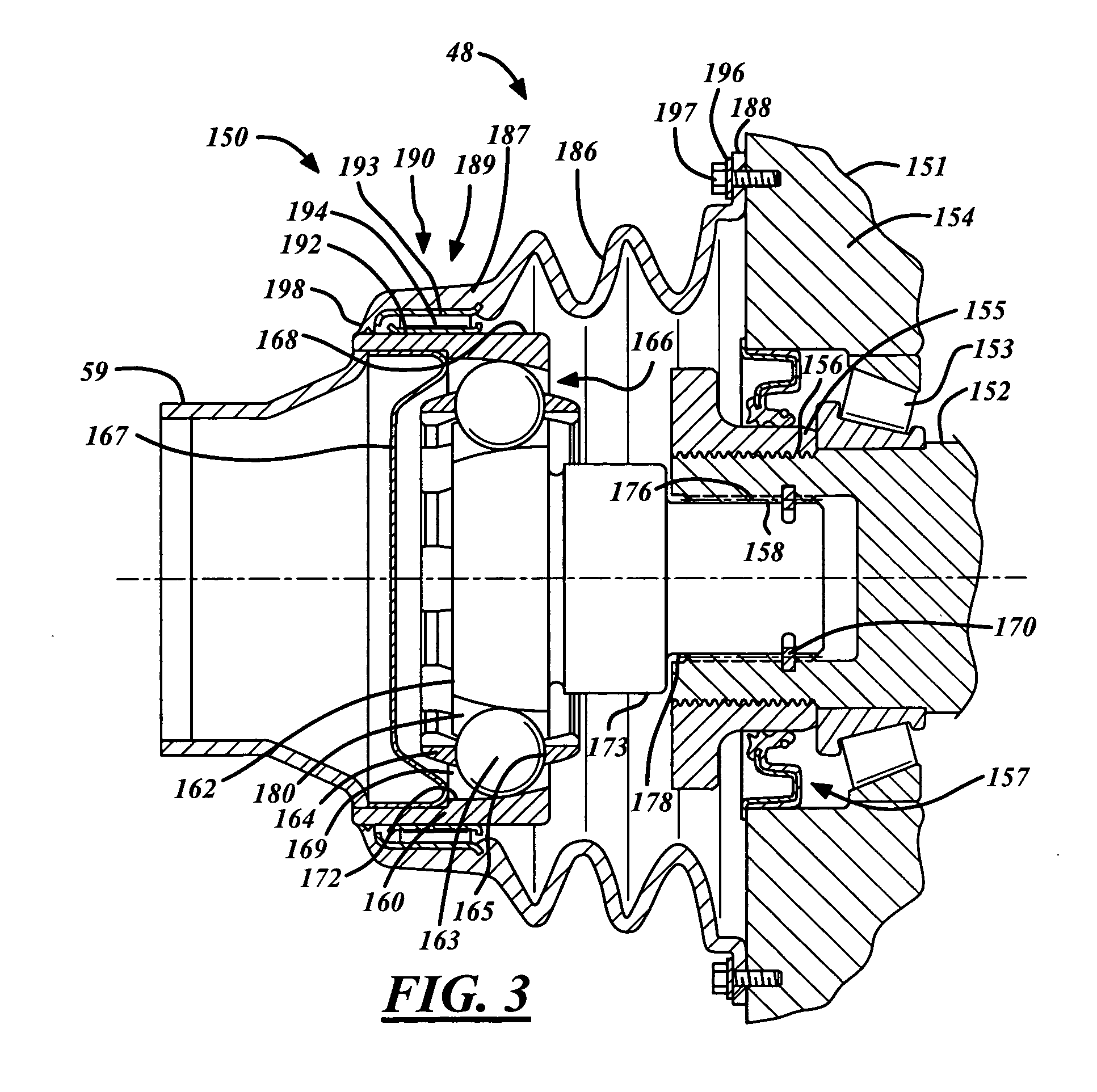Direct torque flow constant velocity joint having a non-rotating boot
a constant velocity joint and torque flow technology, applied in the direction of yielding couplings, shafts and bearings, rotary machine parts, etc., can solve the problems of reducing the overall joint performance, requiring an increase in the joint design envelope, and reducing the torque transfer capability, so as to reduce the radial and axial clearance, improve inspection, and increase flexibility
- Summary
- Abstract
- Description
- Claims
- Application Information
AI Technical Summary
Benefits of technology
Problems solved by technology
Method used
Image
Examples
first embodiment
[0018]FIG. 2 shows an inventive direct torque flow constant velocity joint 50 being used to advantage. The inventive DTF CVJ connector 50 is shown assembled to a shaft journal 52 of a transmission 51 thereby forming an indirect DTF connection 49. The shaft journal 52 is supported by a bearing 53 in a housing 54, which, in this case, is illustrated in the form of a housing in the transmission drive unit of a motor vehicle. The bearing 53 is axially tensioned by a tensioning nut 55, which has been threaded on to a threaded portion 56 of the shaft journal 52. A shaft seal 57 optionally seals the tensioning nut 55 relative to the transmission housing 54. Moreover, the shaft seal 57 serves to ensure that transmission oil does not leak into the chamber created by the DTF CVJ 50. Also, the shaft seal 57 reduces the amount of joint lubrication being expelled into the transmission 51. The shaft journal 52 includes toothed or splined shaft portion 58 for receiving the DTF CVJ connector 50. Ge...
second embodiment
[0027]FIG. 3 shows an inventive direct torque flow constant velocity joint 150 being used to advantage. The inventive DTF CVJ connector 150 is shown assembled to a shaft journal 152 of a transmission 151 thereby forming a direct DTF connection 48. The shaft journal 152 is supported by a bearing 153 in a housing 154, which, in this case, is illustrated in the form of a housing in the transmission drive unit of a motor vehicle. The bearing 153 is axially tensioned by a tensioning nut 155, which has been threaded on to a threaded portion 156 of the shaft journal 152. A shaft seal 157 optionally seals the tensioning nut 155 relative to the transmission housing 154. Moreover, the shaft seal 157 serves to ensure that transmission oil does not leak into the chamber created by the direct DTF connection 48. Also, the shaft seal 157 reduces the amount of joint lubrication being expelled into the transmission 151. The shaft journal 152 includes toothed or splined shaft portion 158 for receivin...
PUM
 Login to View More
Login to View More Abstract
Description
Claims
Application Information
 Login to View More
Login to View More - R&D
- Intellectual Property
- Life Sciences
- Materials
- Tech Scout
- Unparalleled Data Quality
- Higher Quality Content
- 60% Fewer Hallucinations
Browse by: Latest US Patents, China's latest patents, Technical Efficacy Thesaurus, Application Domain, Technology Topic, Popular Technical Reports.
© 2025 PatSnap. All rights reserved.Legal|Privacy policy|Modern Slavery Act Transparency Statement|Sitemap|About US| Contact US: help@patsnap.com



